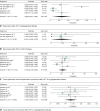Systematic review and meta-analysis of endorectal advancement flap and ligation of the intersphincteric fistula tract for cryptoglandular and Crohn's high perianal fistulas
- PMID: 31183438
- PMCID: PMC6551488
- DOI: 10.1002/bjs5.50129
Systematic review and meta-analysis of endorectal advancement flap and ligation of the intersphincteric fistula tract for cryptoglandular and Crohn's high perianal fistulas
Erratum in
-
Systematic review and meta-analysis of endorectal advancement flap and ligation of the intersphincteric fistula tract for cryptoglandular and Crohn's high perianal fistulas.BJS Open. 2020 Feb;4(1):166-167. doi: 10.1002/bjs5.50249. BJS Open. 2020. PMID: 32011811 Free PMC article. No abstract available.
Abstract
Background: High perianal fistulas require sphincter-preserving surgery because of the risk of faecal incontinence. The ligation of the intersphincteric fistula tract (LIFT) procedure preserves anal sphincter function and is an alternative to the endorectal advancement flap (AF). The aim of this study was to evaluate outcomes of these procedures in patients with cryptoglandular and Crohn's perianal fistulas.
Methods: A systematic literature search was performed using MEDLINE, Embase and the Cochrane Library. All RCTs, cohort studies and case series (more than 5 patients) describing one or both techniques were included. Main outcomes were overall success rate, recurrence and incontinence following either technique. A proportional meta-analysis was performed using a random-effects model.
Results: Some 30 studies comprising 1295 patients were included (AF, 797; LIFT, 498). For cryptoglandular fistula (1098 patients), there was no significant difference between AF and LIFT for weighted overall success (74·6 (95 per cent c.i. 65·6 to 83·7) versus 69·1 (53·9 to 84·3) per cent respectively) and recurrence (25·6 (4·7 to 46·4) versus 21·9 (14·8 to 29·0) per cent) rates. For Crohn's perianal fistula (64 patients), no significant differences were observed between AF and LIFT for overall success rate (61 (45 to 76) versus 53 per cent respectively), but data on recurrence were limited. Incontinence rates were significantly higher after AF compared with LIFT (7·8 (3·3 to 12·4) versus 1·6 (0·4 to 2·8) per cent).
Conclusion: Overall success and recurrence rates were not significantly different between the AF and LIFT procedure, but continence was better preserved after LIFT.
Figures




References
-
- Zanotti C, Martinez‐Puente C, Pascual I, Pascual M, Herreros D, García‐Olmo D. An assessment of the incidence of fistula‐in‐ano in four countries of the European Union. Int J Colorectal Dis 2007; 22: 1459–1462. - PubMed
-
- Vogel JD, Johnson EK, Morris AM, Paquette IM, Saclarides TJ, Feingold DL et al Clinical practice guideline for the management of anorectal abscess, fistula‐in‐ano, and rectovaginal fistula. Dis Colon Rectum 2016; 59: 1117–1133. - PubMed
-
- Magro F, Gionchetti P, Eliakim R, Ardizzone S, Armuzzi A, Barreiro‐de Acosta M et al; European Crohn's and Colitis Organisation (ECCO) . Third European evidence‐based consensus on diagnosis and management of ulcerative colitis. Part 1: definitions, diagnosis, extra‐intestinal manifestations, pregnancy, cancer surveillance, surgery, and ileo‐anal pouch disorders. J Crohns Colitis 2017; 11: 649–670. - PubMed
-
- Nederlandse vereniging voor Heelkunde . Richtlijn Proctologie https://www.huidziekten.nl/richtlijnen/richtlijn‐proctologie‐2015.pdf [accessed 1 March 2018].
-
- Christoforidis D, Pieh MC, Madoff RD, Mellgren AF. Treatment of transsphincteric anal fistulas by endorectal advancement flap or collagen fistula plug: a comparative study. Dis Colon Rectum 2009; 52: 18–22. - PubMed
Publication types
MeSH terms
LinkOut - more resources
Full Text Sources
Medical

